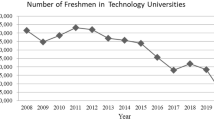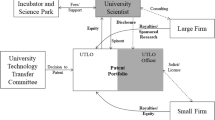Abstract
The paper investigates the productivity level of technology transfer offices (TTOs) affiliated to Spanish public universities. The proposed approach allows the development of a framework that matches universities’ technology transfer concerns with the need to accurately analyze the role of the outcome configuration of TTOs. We analyze the productivity of Spanish TTOs during 2006–2011 by computing total factor productivity models rooted in non-parametric techniques, namely the Malmquist index. The results confirm that technology transfer productivity is affected by changes in the configuration of the TTO’s outcome portfolio that result from benchmarking own and market peers’ performance levels. While benchmarking own performance levels facilitates the exploitation of internal resources and yields superior productivity results, changes in TTO’s portfolio based on comparisons with market peers might generate greater operational costs that negatively impact productivity.



Similar content being viewed by others
Notes
It should be kept in mind that, during the analyzed period, reliable data on the TTO’s budget are not available from the RedOTRI annual reports for 12 universities.
Although it is not the case in our data, we extend the analysis to the case of zero values in the input set. Zero input values are problematic in DEA models. From an economic point of view, zero input values indicate that the focal unit can produce outputs without consuming resources, which leads to unfeasible DEA scores (see Thanassoulis et al. 2008 for a comprehensive review on this issue).
Literature on the definition and causes of technical change is extensive. In this study, technical change refers to shifts of the production function in the input–output space that originate from different combinations in the input-mix and the output-mix. In the context of non-parametric productivity models, a more in-depth analysis of technical change can be found in Kumar and Russell (2002) and Grifell-Tatjé and Lovell (2015).
References
Agasisti, T., & Wolszczak-Derlacz, J. (2015). Exploring efficiency differentials between Italian and Polish universities, 2001–11. Science and Public Policy, 43(1), 128–142.
Algieri, B., Aquino, A., & Succurro, M. (2013). Technology transfer offices and academic spin-off creation: The case of Italy. Journal of Technology Transfer, 38(4), 382–400.
Ambos, T. C., Mäkelä, K., Birkinshaw, J., & D’Este, P. (2008). When does university research get commercialized? Creating ambidexterity in research institutions. Journal of Management Studies, 45(8), 1424–1447.
Anderson, T. R., Daim, T. U., & Lavoie, F. F. (2007). Measuring the efficiency of university technology transfer. Technovation, 27(5), 306–318.
Baldini, N. (2009). Implementing Bayh–Dole-like laws: Faculty problems and their impact on university patenting activity. Research Policy, 38(8), 1217–1224.
Balsmeier, B., & Pellens, M. (2014). Who makes, who breaks: Which scientists stay in academe? Economics Letters, 122(2), 229–232.
Baum, J. A. C., & Dahlin, K. B. (2007). Aspiration performance and railroads’ patterns of learning from train wrecks and crashes. Organization Science, 18(3), 368–385.
Berbegal-Mirabent, J., Lafuente, E., & Solé, F. (2013). The pursuit of knowledge transfer activities: An efficiency analysis of Spanish universities. Journal of Business Research, 66(10), 2051–2059.
Caldera, A., & Debande, O. (2010). Performance of Spanish universities in technology transfer: An empirical analysis. Research Policy, 39(9), 1160–1173.
Caves, D. W., Christensen, L. R., & Diewert, W. E. (1982). The economic theory of index numbers and the measurement of input, output, and productivity. Econometrica, 50, 1393–1414.
Chambers, R. G., & Pope, R. D. (1996). Aggregate productivity measures. American Journal of Agricultural Economics, 78(5), 1360–1365.
Chapple, W., Lockett, A., Siegel, D., & Wright, M. (2005). Assessing the relative performance of UK university technology transfer offices: Parametric and non-parametric evidence. Research Policy, 34(3), 369–384.
Chen, M.-J., & Miller, K. (2007). Competitive tension: The awareness–motivation–capability perspective. Academy of Management Journal, 50(1), 101–118.
Clarysse, B., Wright, M., Lockett, A., Van de Velde, E., & Vohora, A. (2005). Spinning out new ventures: A typology of incubation strategies from European research institutions. Journal of Business Venturing, 20, 183–216.
Commission, European. (2015). Annual report on the ERC activities and achievements in 2014. Luxembourg: Publications Office of the European Union.
Cooper, W. W., Seiford, L. M., & Zhu, J. (2011). Handbook on data envelopment analysis (2nd ed.). New York, NY: Springer.
Di Gregorio, D., & Shane, S. (2003). Why do some universities generate more start-ups than others? Research Policy, 32, 209–227.
Dill, D. D. (2014). Public policy design and university reform: Insights into academic change. In C. Musselin & P. N. Teixeira (Eds.), Reforming higher education (pp. 21–37). The Netherlands: Springer.
Etzkowitz, H., Webster, A., Gebhardt, C., & Terra, B. R. C. (2000). The future of the university and the university of the future: Evolution of ivory tower to entrepreneurial paradigm. Research Policy, 29, 313–330.
Färe, R., Grosskopf, S., Lindgren, B., & Roos, P. (1989). Productivity developments in Swedish hospitals: A Malmquist output index approach. In A. Charnes, W. W. Cooper, A. Y. Lewin, & L. Seiford (Eds.), Data envelopment analysis: Theory, methodology, and applications (pp. 253–272). The Netherlands: Springer.
Feldman, M., Feller, I., Bercovitz, J., & Burton, R. (2002). Equity and the technology transfer strategies of American research universities. Management Science, 48, 105–121.
Fitzgerald, C., & Cunningham, J. A. (2016). Inside the university technology transfer office: Mission statement analysis. Journal of Technology Transfer, 41(5), 1235–1246.
Friedman, J., & Silberman, J. (2003). University technology transfer: Do incentives, management, and location matter? Journal of Technology Transfer, 28(1), 17–30.
Greene, W. (2003). Econometric analysis (5th ed.). Upper Saddle River, NJ: Prentice Hall.
Greve, H. R. (1998). Performance, aspirations, and risky organizational change. Administrative Science Quarterly, 43(1), 58–86.
Grifell-Tatjé, E., & Lovell, C. A. K. (1999). Profits and productivity. Management Science, 45(9), 1177–1193.
Grifell-Tatjé, E., & Lovell, C. A. K. (2015). Productivity accounting: The economics of business performance. New York, NJ: Cambridge University Press.
Guerrero, M., & Urbano, D. (2012). The development of an entrepreneurial university. Journal of Technology Transfer, 37(1), 43–74.
Hausman, J. (1978). Specification tests in econometrics. Econometrica, 46, 1251–1271.
Hsu, D. W., Shen, Y. C., Yuan, B. J., & Chou, C. J. (2015). Toward successful commercialization of university technology: Performance drivers of university technology transfer in Taiwan. Technological Forecasting and Social Change, 92, 25–39.
Iyer, D. N., & Miller, K. D. (2008). Performance feedback, slack, and the timing of acquisitions. Academy of Management Journal, 51(4), 808–822.
Kahneman, D., & Tversky, A. (1979). Prospect theory: Analysis of decision under risk. Econometrica, 47(2), 263–292.
Kim, Y. (2013). The ivory tower approach to entrepreneurial linkage: Productivity changes in university technology transfer. Journal of Technology Transfer, 38(2), 180–197.
Kumar, S., & Russell, R. R. (2002). Technological change, technological catch-up, and capital deepening: Relative contributions to growth and convergence. American Economic Review, 92(3), 527–548.
Labianca, G., Fairbank, J. F., Andrevski, G., & Parzen, M. (2009). Striving toward the future: Aspiration–performance discrepancies and planned organizational change. Strategic Organization, 7(4), 433–466.
Lafuente, E., & Berbegal-Mirabent, J. (2017). Contract employment policy and research productivity of knowledge workers: An analysis of Spanish universities. International Journal of Human Resource Management. doi:10.1080/09585192.2017.1323226.
Levinthal, D. A., & March, J. G. (1981). A model of adaptive organizational search. Journal of Economic Behavior and Organization, 2(4), 307–333.
Levitt, B., & March, J. (1988). Organizational learning. Annual Review of Sociology, 14, 319–340.
Macho-Stadler, I., Pérez-Castrillo, D., & Veugelers, R. (2007). Licensing of university inventions: The role of a technology transfer office. International Journal of Industrial Organization, 25(3), 483–510.
Malmquist, S. (1953). Index numbers and indifference surfaces. Trabajos de Estadística, 4(2), 209–242.
Perkmann, M., Tartari, V., McKelvey, M., Autio, E., Broström, A., D’Este, P., et al. (2013). Academic engagement and commercialisation: A review of the literature on university–industry relations. Research Policy, 42(2), 423–442.
Perkmann, M., & Walsh, K. (2009). The two faces of collaboration: Impacts of university–industry relations on public research. Industrial and Corporate Change, 18(6), 1033–1065.
Podinovski, V. V., & Thanassoulis, E. (2007). Improving discrimination in data envelopment analysis: Some practical suggestions. Journal of Productivity Analysis, 28(1–2), 117–126.
Sellenthin, M. O. (2009). Technology transfer offices and university patenting in Sweden and Germany. Journal of Technology Transfer, 34(6), 603–620.
Sengupta, J. K. (1987). Efficiency measurement in non-market systems through data envelopment analysis. International Journal of Systems Science, 18(12), 2279–2304.
Shattock, M. (2009). Entrepreneurialism and organizational change in higher education. In M. Shattock (Ed.), Entrepreneurialism in universities and the knowledge economy (pp. 1–8). Maidenhead: Society for Research into Higher Education and Open University Press.
Siegel, D. S., Veugelers, R., & Wright, M. (2007). Technology transfer offices and commercialization of university intellectual property: Performance and policy implications. Oxford Review of Economic Policy, 23(4), 640–660.
Siegel, D. S., Waldmann, D. A., & Link, A. N. (2003). Assessing the impact of organisational practices on the productivity of university technology transfer offices: An exploratory study. Research Policy, 32(1), 27–48.
Thanassoulis, E., Portela, M. C. S., & Despic, O. (2008). DEA—The mathematical programming approach to efficiency analysis. In H. Fried, C. A. K. Lovell, & S. Schmidt (Eds.), The measurement of productive efficiency and productivity growth (pp. 251–420). New York, NY: Oxford University Press.
Thursby, J. G., & Kemp, S. (2002). Growth and productive efficiency of university intellectual property licensing. Research Policy, 31(1), 109–124.
Thursby, J. G., & Thursby, M. C. (2002). Who is selling the ivory tower: Sources of growth in university licensing. Management Science, 48(1), 90–104.
Vinig, T., & Lips, D. (2015). Measuring the performance of university technology transfer using meta data approach: The case of Dutch universities. Journal of Technology Transfer, 40(6), 1034–1049.
Wooldridge, J. (2002). Econometric analysis of cross section and panel data. Cambridge, MA: MIT Press.
Wright, M., Siegel, D. S., & Lockett, A. (2007). The rise of entrepreneurial activity at universities: Organizational and societal implications. Industrial and Corporate Change, 16(4), 489–504.
Acknowledgements
For their ideas and insightful comments that helped us to improve the paper we are grateful to Tommaso Agasisti (Politecnico di Milano School of Management) and seminar participants at the 4th Workshop on Efficiency in Education (2016). Esteban Lafuente acknowledges financial support from the Spanish Ministry of Science and Innovation (Grant No. ECO2013-48496-C4-4-R).
Author information
Authors and Affiliations
Corresponding author
Appendix
Appendix
See Table 6.
Rights and permissions
About this article
Cite this article
Lafuente, E., Berbegal-Mirabent, J. Assessing the productivity of technology transfer offices: an analysis of the relevance of aspiration performance and portfolio complexity. J Technol Transf 44, 778–801 (2019). https://doi.org/10.1007/s10961-017-9604-x
Published:
Issue Date:
DOI: https://doi.org/10.1007/s10961-017-9604-x
Keywords
- Technology transfer
- Technology transfer office
- Universities
- Total factor productivity
- Data envelopment analysis
- Aspiration performance




